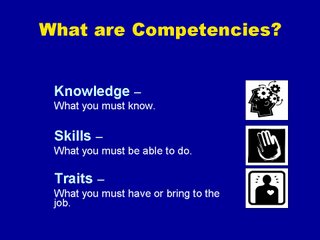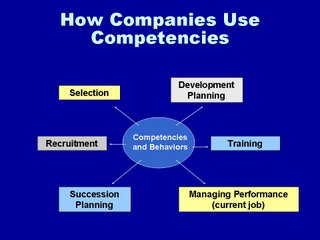This blog entry is dedicated to keeping your explanation of competencies and behaviors as simple as possible. It's easy to over-explain, use consultant/HR jargon or just overcomplicate the whole idea of competencies and behaviors. That's when you start to see people checking their watches and cell phones.
I thought it would be helpful to share some of the visuals, analogies and tips we use for explaining the whole concept of competencies and behaviors. We find it helps to start by analyzing your audience - who they are, what they care about and what they relate to. Then put competencies and behaviors into their language, using analogies and examples that they can get their arms around. This makes competencies simpler, more practical and easier for them to implement.
The Competency Yardstick
We use the "yardstick" or "ruler" analogy to show managers and employees that competencies are merely units of measure. A competency profile is a yardstick that sets a standard for what "ideal behavior" looks like. In other words, the competency yardstick shows what the "ideal performer" would look like in terms of how they behave.
It can be used to:
- Take an individual measurement ("What are my current strengths and development needs?"),
- Compare different measurements ("How do I stack up against my peers, using the competency profile as a guide?"),
- Measure growth ("How do I compare to my past measurements? Where have I grown?")
No one is expected to be perfect. The competency yardstick is a model, against which people can assess themselves and others...the goal being to get as close to perfect as possible, and keep getting better over time.
The slide below shows how the competency yardstick can be used in a number of business applications, such as selecting the right people, career planning and development, and managing performance. It's a good discussion starter. I use this slide in all types of meetings and trainings, to reinforce the importance of competencies.

What are Competencies?
"Competency" is a tough word to define, particularly because experts and academics disagree on definitions. Ask 100 consultants what competencies are, and you'll likely get 100 different definitions. Ours is below. We like it because it's simple and most people can relate to it.
Competencies are the things people need to know (knowledge), to do (skills) and have (traits), to be successful in a role. They are defined by behaviors that describe what that competency would look like if someone were using it effectively.
Here's a frequently asked question. "Why do we have to be so specific about putting behaviors and actions into the right competency category, and why be so specific in defining behaviors? Aren't we splitting hairs?" Valid question. It may seem like wordsmithing and being nit-picky. Here's the explanation I give. Labeling the "soft stuff" - behaviors that we observe - and defining them clearly allows us to talk about them. It gives us a common language, so that when we say that we want to improve our Coaching skill (for example)...we all know that we're talking about the same thing. If our competencies, definitions and behaviors are fuzzy or open to interpretation, we'll have misunderstandings and disagreements down the road when we talk about strengths, development needs, performance reviews and who we should hire.
 Another frequently asked question:
Another frequently asked question:"Why group competencies into knowledge, skills and traits/motivations?"
We break them down into knowledge, skills and traits/motivations because the first two - knowledge and skills - are trainable. Personal traits and motivations are deeply engrained in people. In business, sending people to a training class to improve their personality rarely works. Grouping competencies helps us, as managers, understand what's within our control to change and what isn't.
How Companies Use Competencies
We use this visual with all audiences. It's helpful to show over and over again in meetings and training, to remind people of how all "people-systems" are linked in best-practice companies. It can be used as a very simple diagnostic tool, by asking the group: "Where are our systems aligned and where are there gaps?" Or, "Do we hire for the right competencies, then train people to those competencies?" This is also a good visual to use when making the business case to senior leadership for integrated "people-systems". When all of these systems are aligned, and based on competencies that are critical to future business success, the company works efficiently. There is less wasted effort, hiring is more on-target and everyone is working toward common goals.

Analogies
For some people, often those who are numbers or technically oriented, competencies and behaviors are too "squishy". They may have trouble relating to them, or see more value in focusing on numbers and hard data (more tangible ideas). That's where analogies help. Below are some analogies I've used with different audiences to help them understand how to use competencies and behaviors - and see their value.
Just a note...my intent here isn't to stereotype anyone. I acknowledge that every individual is different and unique.
Taking with Engineers or Scientists
Engineers and scientists are trained to look for precise measurements. They like to analyze. Scientists and engineers learn by observing patterns and trends. So they should enjoy working with competencies and behaviors when presented this way. Competencies and behaviors are units of measure that help us take something very intangible - how people behave - and make it more tangible and measurable.
Talking with IT/Systems Groups
A key function of IT or Systems staff is to problem solve and diagnose. They're driven to figure out what's going on and make systems run better.
That's why competencies and behaviors should appeal to IT-types. People are like systems...we're all programmed differently. Competencies and behaviors give us a common language and "platform" from which to assess our behavior, just like programmers, IT analysts, and others need a common language and tools to assess why information systems work and why they don't work.
Talking with Sales Groups
Numbers rule in sales. Salespeople make their money, get recognition and are judged by the numbers they produce. Why care about competencies and behaviors? We like to give examples to show why competencies and behaviors very directly impact sales numbers. "What if you're not making your numbers?" Typical sales manager will say "go sell more" or "make more calls" or "be more aggressive". But how? What does that mean? It's not actionable...doesn't tell the salesperson what they should be doing differently tomorrow when they get in their car. And it doesn't really diagnose what the root problem is. What if the salesperson isn't asking enough questions? What if the salesperson isn't listening to customers? "Go sell more" or "make more calls" won't help. Competencies and behaviors give sales managers and reps tools to diagnose what is working...and what isn't. They help improve the numbers.
Tell me your tips for simplifying competencies and behaviors for people in your organization!
©2006 The Loyalty Group. All Rights Reserved. www.TheLoyaltyGroup.com




3 comments:
Nice article, you've done a good job of simplifying this topic.
I like the way that Pat McClagan used competencies and roles in her competency 1989 study for ASTD (Models for Excellence). She identified 15 roles filled by HRD professionals (Training Delivery, Instructional Design, Training Evaluation, etc.) then created a grid in which the 35 competencies she identified were listed in one row each, with a column for each role. Then it was indicated which competencies were used in each role.
I'm thinking of doing the same thing, yet listing key job functions instead of roles. Have you seen this done?
I'm working to support a Business Unit, so I'd like to do this for my 330+ people (across some # of different positions....TBD!).
I'd appreciate any thoughts or comments.
Thanks.
Hi Pete,
First, thanks for your comments. Competencies isn't a "sexy" topic, but it's at the core of everything "people related" in business. Glad you found the simplification helpful.
I'm going to look up the ASTD study you reference. Just goes to show you, since it was done in 1989, that not much changes!
Regarding your question about defining competencies for key job functions - ABSOLUTELY! There are many ways to do this. The trick is, in the end, making sure that:
- The competencies are aligned across functions, so people see how they connect to each other horizontally...and see their ultimate connection to the customer.
- They're aligned vertically, so even front-line employees can have a "clear line of site" to their business unit and company goals.
- They're written in simple, function-specific language, so they're not just words on a page. People must relate to the competency descriptions if they're going to use them.
- You teach people how to use competencies and behaviors for setting performance expectations, professional and career development, coaching, reviews, etc. Don't assume people will get excited about them when you email the "list" out.
I'd love to talk more about this...it's a sweet spot for TLG. Let me know if I can help!
Regards,
Phyllis Roteman
Hi,
I really liked your article. It is a rare collection of "how to comminicate competencies" to a wide range of professionals.
In my current company we have a new competency framework which will be used in performance management. Nowadays we are preparing a training program to make sure that a wide range of (~4000) people in the company understand the new framework.
I would love to hear if there are any other reources (books, articles, etc.) you would recommend. We are especially interested in resources with learning execises and detailed insights on how to explain competencies.
Thanks a lot!
Post a Comment